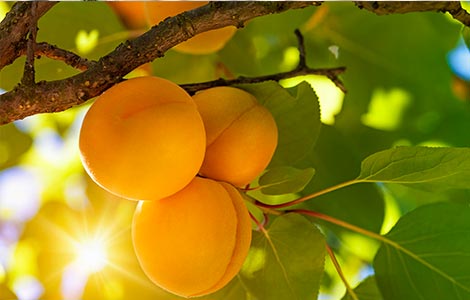
- Foliar nutrient sprays are commonly applied to fruit trees.
- Boron is immobile in most plant tissues so boron may not be readily transported to developing flower buds.
- Solubor® can be effectively applied with dormant oil-insecticide sprays during the dormant stages of most fruit trees.
There are hundreds of multi-element, foliar leaf feed formulations being marketed to fruit tree growers. But are they really useful? While considerable research and debate among scientists and growers has not given a definitive answer, three elements are rising to the top of the list as having the ability to increase yields. Professor Timothy Righetti, of the Oregon State Horticulture Nutrition and Research Program, says foliar-applied boron (B), urea and zinc have shown some promising results.
Boron increases fruit set
“Even though soil and leaf tissue analysis usually show no B deficiency, fruit trees often have difficulty in transporting enough B to new flower buds,” says Righetti. He says B is especially immobile in most plant tissues and will not readily move from other parts of the tree to the buds when it is needed for pollen tube growth, pollen production and other reproductive functions. “Under cool or otherwise poor growing conditions, flowers can deteriorate before fertilization is complete,” says Righetti. “Foliar B enhances fruit set in these situations by accelerating the fertilization process.”
“Foliar boron enhances fruit set by accelerating the fertilization process.” Dr. Timothy Righetti
“We’ve found that a foliar application of B applied either during fall or early spring helps provide flower buds with sufficient B to improve fruit set,” says Righetti. He explains that while improved fruit set will not happen every year with the B application, a yield increase of just a few percent every four years would more than pay for the inexpensive B treatment. “You might not think a few percent increase is very much, but when you compare the high value of crops like apples or pears with the extremely low cost of Solubor, it makes very good sense to use a foliar B treatment.”
Due to the immobility of B in most plant tissues, Righetti says, foliar B sprays will increase fruit set much more effectively than soil-applied B. Also, B in the soil can be leached out of the root zone before it can be absorbed by plant roots.
Solving the nitrogen dilemma
Righetti says that foliar-applied urea may provide a solution to a common problem in fruit production.”Too much nitrogen (N) will make fruit keep poorly and can cause excess vigor in the tree, but backing off on N fertilization can cause trouble at budding and may reduce size or yield.” Righetti says that a 5% foliar urea solution applied post-harvest before leaf senescence provides the needed N for budding without overloading the tree. “Traditional spring N applications will continue to play an important role, but we believe that they can be reduced if other methods of ensuring high N buds can be developed. We are convinced that splitting N applications between soil and foliar applications will allow you to actually reduce the total N inputs,” he says. “Reducing the requirements for soil-applied N provides growers with an economic and an environmental benefit.”
“There is ample evidence that urea assists in the foliar uptake of other nutrients,” says Righetti. “We already know that individual applications of urea, B and zinc can improve performance.”
Practical applications for fruit trees
- Apply 1-3 lbs/acre of Solubor post harvest while leaves are still green.
- Apply 3-5 lbs/acre of Solubor at dormant through delayed dormant stages along with the dormant oil-insecticide.